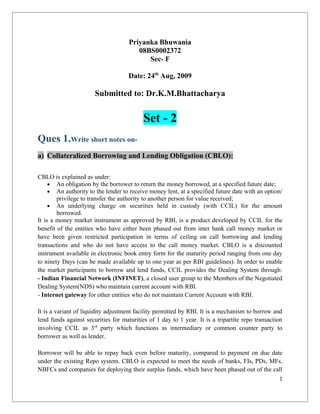CBLO is a money market instrument that allows entities access to borrow and lend funds against securities for short periods of 1 day to 1 year. It involves CCIL acting as an intermediary between the borrower and lender. Capital employed represents the total long-term funds from shareholders and creditors used in a business. It is used to calculate return on capital employed (ROCE). A qualified institutional buyer (QIB) is an institution that can privately purchase securities from listed companies to help companies raise funds within India's domestic market. The statutory liquidity ratio (SLR) is the minimum fraction of deposits that banks must maintain as liquid assets like government securities and cash.




![• To transfer a high risk project/ asset from the parent company to SPV
• Different countries have different tax rates for capital gains and gains from property
sales. SPVs created in different countries thereby help to have tax-gains.
• For regulatory reasons and
• For competitive reasons.
Ques. 2
(a) What is the yield, if the face value of 364 days T. Bill is Rs 100 and if the
purchase price is 90 for T. Bill?
Ans. The rupee income the buyer makes for 364 days investment is Rs.10 per bill and the return
on his investment works out to be:
- 1] *
=
= 11.14% per annum.
2. (b) Ever Grow Bank purchased commercial paper for Rs 19,40,000 with a
face value of Rs 20,00,000. Maturity Period 6 months. Calculate the yield for
the bank.
Ans. Yield for the bank =
=
= 0.06 or 6%.
5](https://image.slidesharecdn.com/set-2-091201114507-phpapp01/85/Set-2-5-320.jpg)